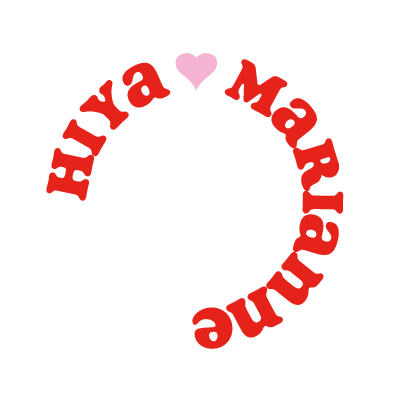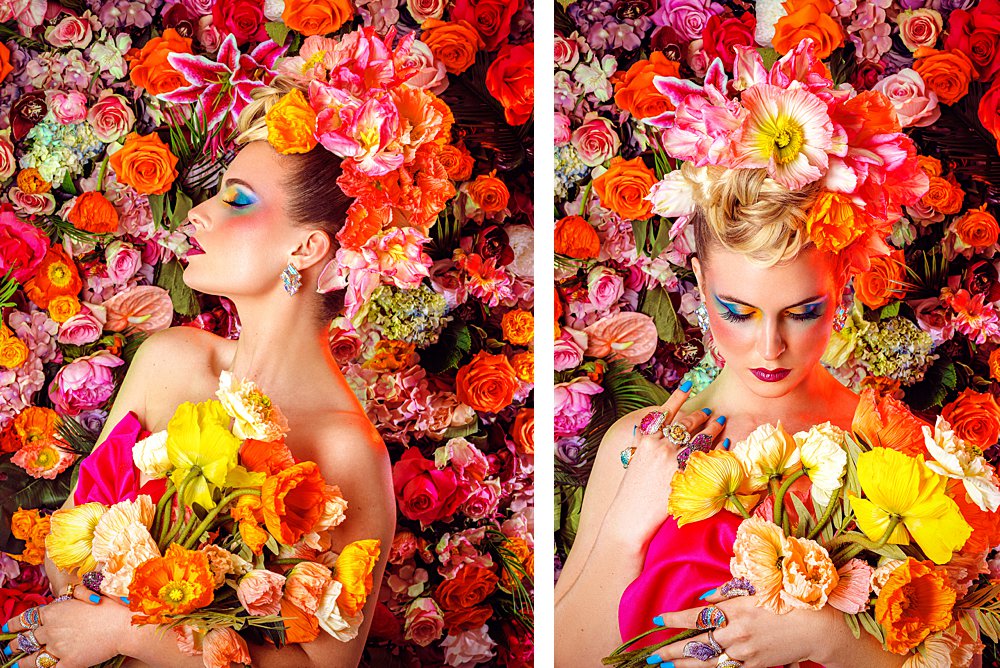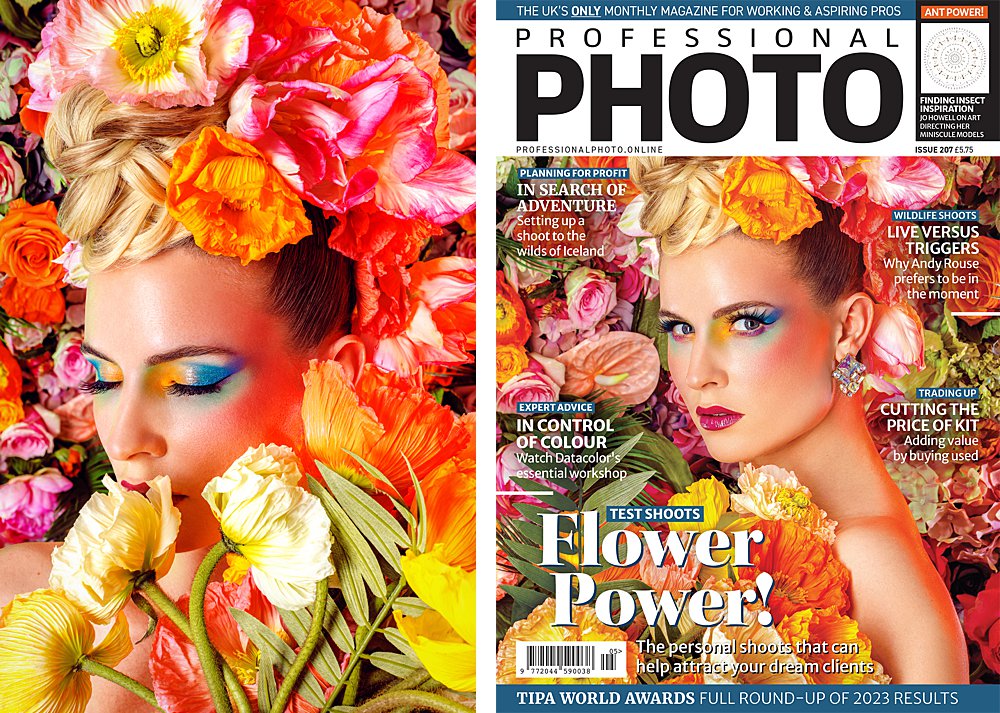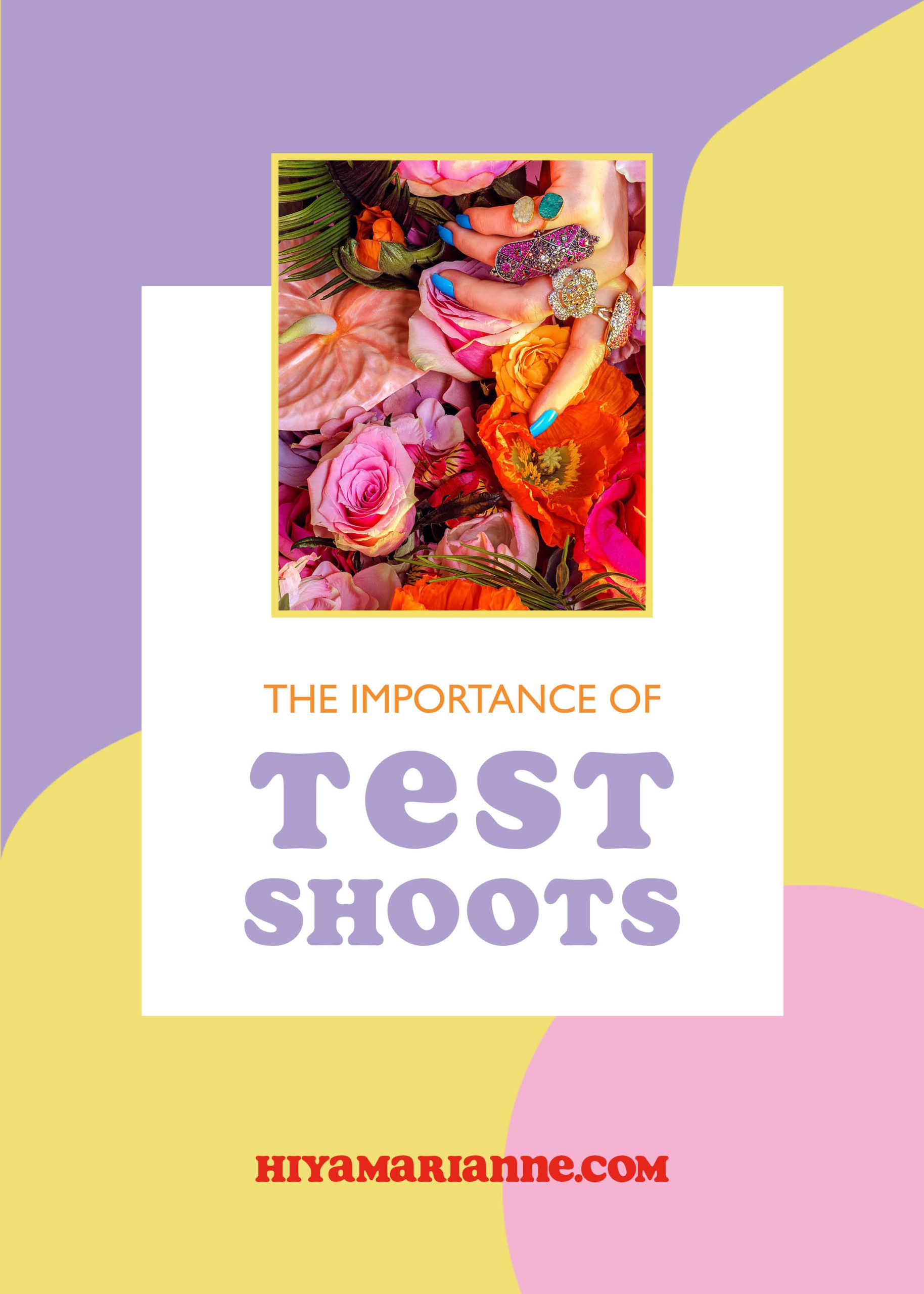
If it’s your dream to book a certain type of client or produce work that has a definite style that gets noticed, you need to take test shoots seriously. I think most photographers would agree that getting to work in a style that excites you the most is the dream, and that when you do work that has gravitas, better-aligned clients generally follow. And yet, looking through many photographers’ portfolios, there is often a little bit of extra sparkle missing. If you want to turn your portfolio into dream-client converting super machine, you need to invest actual time and money into testing.
What is a test shoot
Test shoots can sometimes be called just personal shoots or portfolio shoots to indicate that they are not commercial shoots briefed and paid for by a client. I like the term test shoot because it gets you more focused. With a test shoot you are testing something new, whether that would be a new idea or aesthetic for your portfolio, a new lighting technique or new gear, or perhaps working with a new collaborator such as a food stylist or a model. The purpose is to produce the kind of work that you WANT to be creating professionally, the kind of work that will shine in your portfolio and catch the eye of a potential dream client. This is why calling these shoots just ‘personal shoots’ feels a bit wishy-washy. It’s not just about shooting something for fun like you would do as a hobbyist, but rather having a clear goal and purpose.
What a test shoot isn’t
I often hear photographers and clients new to the commercial world using the term test shoot in entirely the wrong context. A test shoot is not a shoot where a new client might want to ‘test’ you before they commit to working together. It is not a shoot where you shoot for free or in exchange of product because ‘you’re new’. You are not the one being tested, you are the one testing what new exciting things you can create in order to attract clients who would not think of trying to get you to work for free.
The difference between test shoot and spec shoot
Spec shoot is a term that you hear more in the fashion photography world. It’s a shoot where a photographer, who has an idea they think would have a synergy with a certain brand they might want to work with, agrees to ‘shoot on spec’. While the brand may give or lend their clothes or products, the photographer will take the risk of putting together a shoot for the brand, and if at the end of it the brand likes the images, they will agree to pay for the costs of the shoot and to license the images. If they decide not to, the photographer will have spent money on the shoot, but will walk away with images with a brand they dreamed of for their portfolio.
How does that differ from working for free you may ask? The crucial component to a spec shoot is that the photographer has the full creative control. They are approaching a brand they feel an affinity with, creating the kind of work that will hopefully blow the brand’s – and everyone else’s – socks off. Plus, if the brand decides not to license the images, they will not be able to use them for their own marketing. It is not the other way round where a random brand would approach a photographer, asking them to work in exchange of products (or worse, ‘exposure’) that wouldn’t necessarily be that perfect fit for the photographer’s portfolio anyway, while getting free images to use.
What to shoot
There’s a temptation to treat test shoots as recreational, something fun to get the creative juices flowing. And while there’s certainly value in that, you should be much more intentional.
To begin with, write a list of clients you’d love to work for. Study the imagery they use in their advertising. Then look at your portfolio and identify what’s missing, where are the gaps that need fortifying in order to attract someone like them. Do you want to shoot more hair products, but you only have a couple of images of them in your portfolio? Plan a hair product test shoot to fill this gap. Push yourself further and look at the gaps in your dream clients’ imagery. What could you do differently to showcase their message? Use that as the inspiration for your test shoot.
Once you know what you’re shooting, put together a shoot plan like you would for a paid job. If you turn up on the day with a vague idea of the product or a scene, you’ll most likely end up with images that can be a bit… boring. When you have a solid plan for a shoot that tells a story that you’re directing, you will end up with images that will be much more distinct and that will make potential clients notice your work.
How much to spend
How much to spend on a test shoot depends on your idea. If it’s something you can shoot on your own in your own studio without the help of other talent or suppliers, you can get away with just spending on whatever props or backgrounds you might need for the shoot, plus any possible retouching. The bigger your idea, the more money you will have to dish out. You may be able to put together a team of talent who would be happy to collaborate in return of being able to use the images in their own portfolios. But sometimes your idea might be such that it makes sense to you and your portfolio only, in which case you would need to pay for any other suppliers involved. The cost of a test shoot can run from a couple of hundred pounds to thousands. For me, the cost of test shoots is part of my annual marketing budget.
CASE STUDY: Bird of Paradise
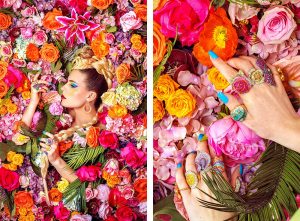 In the past year, I stopped offering lifestyle shoots with models and only really have models come in when I need a hand model for a still image. Alas, I do miss working with a team at times and I’m trying to find a way to add model work back to my portfolio – but in a more creative way than just shooting models on the beach or in front of a seamless paper backdrop. I want to be able to offer shoots that would be aesthetically elevated, and my aim is to show that I can create big ideas in a small space, ideas that would work on a billboard for a big commercial client. I also want to work more with florals, both in my still life and any possible model work, so I wanted to do a test shoot with these two important portfolio-building themes going for it.
In the past year, I stopped offering lifestyle shoots with models and only really have models come in when I need a hand model for a still image. Alas, I do miss working with a team at times and I’m trying to find a way to add model work back to my portfolio – but in a more creative way than just shooting models on the beach or in front of a seamless paper backdrop. I want to be able to offer shoots that would be aesthetically elevated, and my aim is to show that I can create big ideas in a small space, ideas that would work on a billboard for a big commercial client. I also want to work more with florals, both in my still life and any possible model work, so I wanted to do a test shoot with these two important portfolio-building themes going for it.
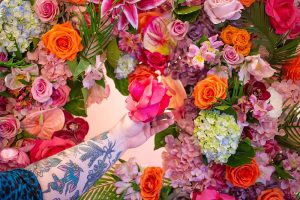 The Bird of Paradise test shoot started as an image that just appeared in my head and refused to go away. In my mind, I saw a model with colourful makeup and hands dripping with sparkly rings, nestled among a wall of flowers. An image that would be exciting as a floral installation but would also lend itself to ideas within product photography. I knew that to pull this off, I’d want to work with a team I could trust to help bring this idea to life. When I lived in London, I used to often do shoots with florist Steph (@fairynuffflowers) and hair stylist Severin (@severinhairstylist), and I managed to put together a shoot plan that got them excited enough to travel all the way to Cornwall to put this shoot together. I then added local model Lydia (@lydia_cooke) and make-up artist Keeleigh (@kjrhairandmakeup) to the mix to complete the team. Afterwards, I also added retoucher Kim (@kimmuneri) as I wanted the images to have a more polished look than I could achieve with my skills. I myself took on the roles of Art Director, stylist and photographer.
The Bird of Paradise test shoot started as an image that just appeared in my head and refused to go away. In my mind, I saw a model with colourful makeup and hands dripping with sparkly rings, nestled among a wall of flowers. An image that would be exciting as a floral installation but would also lend itself to ideas within product photography. I knew that to pull this off, I’d want to work with a team I could trust to help bring this idea to life. When I lived in London, I used to often do shoots with florist Steph (@fairynuffflowers) and hair stylist Severin (@severinhairstylist), and I managed to put together a shoot plan that got them excited enough to travel all the way to Cornwall to put this shoot together. I then added local model Lydia (@lydia_cooke) and make-up artist Keeleigh (@kjrhairandmakeup) to the mix to complete the team. Afterwards, I also added retoucher Kim (@kimmuneri) as I wanted the images to have a more polished look than I could achieve with my skills. I myself took on the roles of Art Director, stylist and photographer.
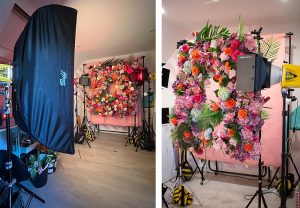 With the florist, we started on the build of the flower wall the day before the shoot, first building a framework which then got filled with artificial flowers as a base layer. On the shoot day, while the model was in hair and make-up, we finished the wall with fresh flowers, which took a good few hours. Once finished, there was a window of around two hours in which to nail the images before the flowers would start to wilt. Since I had planned the shoot and my team carefully, everything ran really smoothly and there were no huge surprised on the day. Mind you, the teardown afterwards was possibly even more lengthy and tiring than the build!
With the florist, we started on the build of the flower wall the day before the shoot, first building a framework which then got filled with artificial flowers as a base layer. On the shoot day, while the model was in hair and make-up, we finished the wall with fresh flowers, which took a good few hours. Once finished, there was a window of around two hours in which to nail the images before the flowers would start to wilt. Since I had planned the shoot and my team carefully, everything ran really smoothly and there were no huge surprised on the day. Mind you, the teardown afterwards was possibly even more lengthy and tiring than the build!
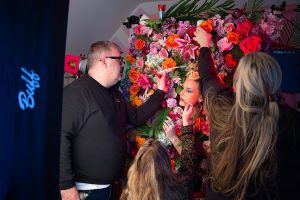 Since this was quite a high-investment test shoot especially when it came to the florist’s time and cost of flowers, we also did a separate still image test shoot the following day in order to make the most of all the flowers. Adding more florals to my product portfolio is something I’m actively working on, so it felt like the perfect way to make sure the time and money was spent as intentionally as possible.
Since this was quite a high-investment test shoot especially when it came to the florist’s time and cost of flowers, we also did a separate still image test shoot the following day in order to make the most of all the flowers. Adding more florals to my product portfolio is something I’m actively working on, so it felt like the perfect way to make sure the time and money was spent as intentionally as possible.
All in all, this test shoot was definitely one of the larger ones I’ve done, and I don’t generally do anything as big more than 1-2 times a year. All the planning, logistics and time on the shoot itself takes a lot of time out of your calendar. But it’s good to plan at least one very ambitious shoot every year, as often those are the ones that yield the star images for your portfolio.
Schedule test shoots for the year ahead
When you plan your year, start by scheduling in test shoot days, the same as you would your paying jobs. For each month (or every other month) schedule a day for the shoot itself plus days for pre-production and post-production. Sure, these days might have to be moved around a bit if an urgent paid job comes in, but having something in the calendar makes you take them seriously instead of just waiting for ‘when you have some free time’. Aim for creating a certain amount of portfolio images per year – maybe that will be 24 images, which means you should create 2 images per month.
The biggest takeaway is, you should treat test shoots as an integral part of driving your business and your portfolio, not as something you do purely for fun. Although, you’re absolutely allowed to have fun doing them!
The Bird of Paradise shoot was featured on the cover of a magazine, so it was definitely all worthwhile! If you want to see more images from this shoot, you can find the project here.
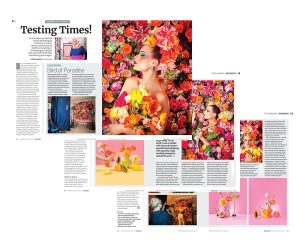
A version of this articly was originally published in Professional Photo magazine issue 207.
